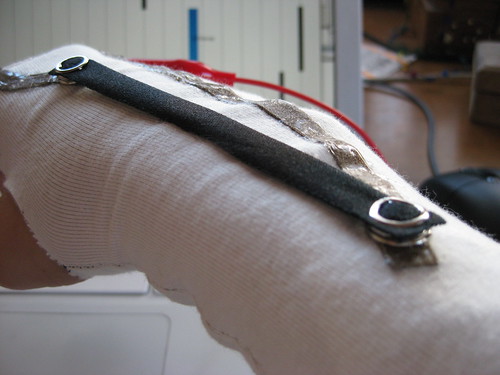Creating stretch sensors from stretchy fabrics that have conductive/resistive properties that change depending on the stretching of the fabric. I’m hoping this will allow to make super simple stretch sensors and lead to other interesting possibilities.
So far we have tested a range of Eeonyx stretchy fabrics that are coated in doped polypyrrole, an inherently conducting polymer. The first results are interesting, but we have yet to test these in a specific situation.



In this video I am testing four different stretch conductive fabrics from Eeonyx. Numbers 1, 2, 3 and 9 based on the total number of ten that they sent me. You can see details in the photo of the chart bellow.
11 Comments so far








[…] Homemade bend sensor Homemade Fabric/Stretch Sensor Electroluminescent “wire” (EL-wire) (4.95 $) Alcohol sensor (4.50$) Solenoid (1.42 $) Linear […]
hey,
I ordered some conductive fabrics last week and have been trying a few things too..your experiments are really nice.
Could you tell more about the circuit to the micro-controller.(for e.g circuit schematic)
Thanks A lot!
I connected the fabrics to the analog to digital converter pin of an Arduino board. In most cases the (10-20K) pull-up resistors worked well but sometimes i got better results by using external 5K or over 100K pull-ups. To smooth the readings you can add a low-pass filter, which you would do by placing a 4.7 to 10 uF capacitor in parallel to the pull-up resistor (from analog input to VCC).
Hope this helps!
yep, thanks a ton 🙂
though my circuit is still quite noisy,I managed to get some results. I am working with a small sample of electrolycra in which the resistance change is very little for which i had to also use an Opamp.
Overall, i think this is a good start 🙂 thanks again!
Hi, this looks like awesome research. Based on your table of stretch and resistance for each sample. #1 looks the most promising for detecting various stretch percentages; do you by any chance know the Eeonxy part number for sample #1? I would like to order some to experiment with myself. If you’ve made any further progress I would also be interested in hearing about it.
Thanks.
i added a photo of the Eeonyx sample sheet. the item numbers batch the numbers in the video.
hope this helps!
That helps a lot; thanks!
[…] Knit Stretch Sensors by Kobakant Constructed Stretch Sensors by Kobakant Fabric Stretch Sensors by Kobakant Finger Sensor by […]
Hi-
this is an old thread and unfortunately, Eeonyx does not seem to carry these products anymore. Does anyone know where to source fabric that would act as a somewhat precise stretch sensor? Thanks!
Can you please tell me what kind of software you used? Thanks!
[…] Resistive carbon coated stretch fabric Eeonyx Company: Eeonyx Characteristics: Resistive material, stretchy in both direction, can be used to make stretch sensor example: Fabric Stretch Sensors http://www.kobakant.at/DIY/?p=210 […]